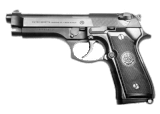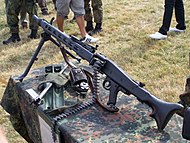Albanian Fascist Militia (Italian Empire)
| Albanian Fascist Militia | |
|---|---|
| Milicia Fashiste Shqiptare Milizia Fascista Albanese | |
 The M.V.S.N. emblem | |
| Active | 1939-present |
| Country | |
| Allegiance | |
| Type | Gendarmerie |
| Role | Riot control Armed security |
| Size | 13,000 troops (incl. K.G.M.K.S.) 4,500 troops (M.F.A. only) |
| Part of | Albanian Fascist Party M.V.S.N. (Kingdom of Italy) |
| Headquarters | Tirana |
| Commanders | |
| Current commander | Consul General Yllor Bizi |
The Albanian Fascist Militia (Albanian: Milicia Fashiste Shqiptare, M.F.S.; Italian: Milizia fascista albanese, M.F.A.) is a fascist paramilitary organization of the Kingdom of Albania formed in 1939 following the Italian invasion of Albania in April 1939, part of the M.V.S.N. The Albanian Fascist Militia is established with the task of contributing to the maintenance of internal order and the security of the state, as well as to guarantee the developments of the fascist revolution.
History
The Albanian Fascist Militia was formed in 1939 following the Italian invasion of Albania in April 1939 It was initially recruited from Italian settlers in Albania, and later on Albanians have been also recruited.
Mission
Missions of the Albanian Fascist Militia include joint operations in securing borders, fighting terrorism and organized crime, as well as maintainance of the public order. The Albanian Fascist Militia also is to work to protect public security and order along with the Albanian Ministry of Interior and guard important state facilities.
Personnel
Recruitment is voluntary and troops are equated with public security agents, as are officers with officers of public security. The officers are appointed by the General Command of the M.V.S.N. in Rome. Differently from the Italian M.V.S.N., the Albanian Fascist Militia is an organization with only permanent service personnel.
Organization
The M.F.S. is directly subordinated to the Albanian Fascist Party (Albanian: Partia Fashiste e Shqipërisë — PFSh). The PFSh assigns it to the Ministry of Interior to quell unrest which do not need of a full-fledged military response. The M.F.S. is headquartered in Tirana and consists of an Albanian General Command and of three Legions.
The M.F.S. is organized as a military force and has a M.V.S.N.-based rank structure. Training is weighted more heavily toward public order matters, but counterinsurgency training is also included. The M.F.S., as separate from the Albanian National Royal Guard, consists of 4,500 troops, subdivided into eight Cohorts.
General Command
The Albanian General Command deals with the coordination and general planning of the activities of the Legions and Cohorts, limited to the aspects of responsibility: organization and functioning of the aforementioned departments, study and experimentation of special equipment, training programs and professional updating.
The General Command is the complex of the managing bodies of M.F.S. The General Command provides disciplinary and administrative functions, as well as policies and requirements for training and funds for the Legions. It is made up of the Commandant General and the General Staff.
Commandant General
The Commandant General of the Albanian Fascist Militia is the commander of the M.F.S. and is appointed and revoked at any time by the Duce of Fascism, after consulting the Commandant General of the M.V.S.N.
The Commandant-General, according to the directives issued by the Political Secretary of the National Fascist Party and of the Secretary of the Albanian Fascist Party, is responsible for the planning, preparation and use of the Militia and prepares the general financial planning and operational joint and defines the resulting technical-financial programs. In addition, the Commandant-General may propose to issue a decree by the Secretary of P.F.Sh. for the reorganization of the Militia.
General Staff
The Albanian Fascist Militia General Staff is a military staff tasked with managing the M.F.S. (and some aspects related to the K.G.M.K.S.):
- Organization Department;
- Public Order Office;
- Training Department;
- Personnel and discipline Department;
- Health Department;
- Administration Department;
- Political Office;
- Legal Affairs Office;
- Army Liaison Office;
- Gendarmerie Liaison Office;
- Press Office.
Territorial organization
The M.F.S. consists of three Legions and five Cohorts dispersed around the Albanian territory:
 1st Legion M.F.S.: Tirana;
1st Legion M.F.S.: Tirana;
- 1st Cohort M.F.S.: Tirana;
- 2nd Cohort M.F.S.: Coriza;
 3rd Legion M.F.S.: Valona;
3rd Legion M.F.S.: Valona;
- 3rd Cohort M.F.S.: Valona;
- 4th Cohort M.F.S.: Scutari;
 5th Legion M.F.S.: Pristina;
5th Legion M.F.S.: Pristina;
- 5th Cohort M.F.S.: Pristina.
Legion
In the Albanian Fascist Militia, the Legion (Albanian: Legjion) is a Regiment-level unit: the operational level is the Cohort (Battalion-level). Each Legion is commanded by a Colonel, who directs all offices subordinated to the Legion Command, in turn held by a Lieutenant Colonel, who also acts as Commander's deputy. Offices and Services are each commanded by a Major or a Captain.
- Legion Command Maniple;
- Chaplain Detachment;
- Personnel Office;
- Medical Service;
- Operations, Information and Training Office;
- Political Office of Investigation;
- 1 to 2 Cohorts.
Cohort
The Cohort (Albanian: Kohortë) is a 500-strong unit which carries out the operational activities and acts as first-level command. Each Cohort is commanded by a Lieutenant Colonel, who leads all units below him. In the M.F.S., a Maniple is 100-legionnaires strong. M.F.S. units are often commanded by active-duty officers. While there is a total of eight Cohorts, five of them are framed within territorial Legions.
- Cohort
- Command Platoon
- Vehicles Platoon
- Public Order Maniple
- Public Order Maniple
- Public Order Maniple
- Operational Intervention Maniple: Operational Intervention Maniples are units are designed to cope with the appropriate urgency in sudden danger to public security, thanks to the special training of personnel and the allocation of substantial vehicles and materials. Operational Intervention Maniples operate in small squads performing patrols in the urban context.
6th Dog Units Cohort
The 6th Dog Units Cohort is an organization of the M.F.S., being its only unit focused on the employment of dogs in public order activity. Subordinated to the General Command, the Cohort is headquartered in Tirana, and has as policing area the entire state. Its main activity is the employment of dogs in activities such as weapons, drugs, explosives, search and capture of lost, buried and/or dead persons and actions of shock, tactical intervention or patrol operations with dogs.
Uniforms and insignia
Albanian Fascist Militia Legionnaires wear their own uniform: dark grey jacket and trousers and a matching cap.
Equipment
The uniforms and equipment are those of the Italian militia but with the white fez, with friezes of the MVSN, and a special badge on the left sleeve, above the elbow. Arms and equipment of state forces include machine guns and armoured cars, in addition to other items generally associated with police.
Riot equipment
The riot gear consists of several elements although they should remain a garment light, simple and easy to wear and at the same time protect the Legionnaire from attacks, kicks, punches and blows. The riot uniform is a black operational suit with a crescent that incorporates the colours of the Albanian flag on the right sleeve and the badge of the Legion. The suit is topped by a "combat vest" which consists of a vest with pockets and a belt that hosts the holster (thigh) of the gun. The personal protective equipment is completed by items like flak jackets, gas masks and riot helmets. The communication is guaranteed by radio transmitting equipment smaller and lighter with headphones so as not to interfere with the agility of the agent.
- Riot helmet: Benelli CAS "Legionario M2000", with back-of-the-neck protector, transparent polycarbonate visor, built-in radio microphone and earpieces.
- Riot shield: Benelli "Scudo M95", polycarbonate, rectangular with rounded corners, curved in the horizontal cross-section to shed thrown objects, and slightly curved in the vertical cross-section at the top and bottom. The size is 75x100 cm.
- Gas mask: Melloni MAG M2000
- Grenade launcher: Beretta LG40
Light weapons
Light weapons used by the M.V.S.N. include personal and unit military weapons. Ordinarily only the personal weapons are carried on external service.
Personal weapons:
| Name | Type | Cartridge | Origin | Photo | Notes |
|---|---|---|---|---|---|
| Beretta 92 FS cal. 9 mm | Semi-automatic pistol | 9×19mm Parabellum |  |
32-round magazine. | |
| Beretta Model 12 | Submachine gun | 9×19mm Parabellum | File:M12S Beretta.jpg | 32-round box magazine. | |
| Beretta AR70/90 | Assault rifle | 9×19mm Parabellum |  |
30-round Magazine/100-round drum magazine |
Unit weapons:
| Name | Type | Cartridge | Origin | Photo | Notes |
|---|---|---|---|---|---|
| MG 42/59 | Machine gun | 7.92×57mm Mauser |  |
General-purpose machine gun, manufactured in Italy | |
| Morelli FP 90 S | Sniper rifle | 12.7×99mm | |||
| Franchi SPAS-15 | Combat shotgun | 12 Gauge |  |
Mortars
The mortars are an important resource in the combat infantry. Simple to use, they can open fire from covered positions a lot and thanks to the target trajectory are strongly arched able to beat a low profile targets to artillery fire. The M.V.S.N. only has light mortars (60 mm); currently the Militia uses the German Hirtenberger 60 mm.
Tactical vehicles
Light multirole vehicle Iveco VTLM Lince in M.V.S.N. livery. M.V.S.N. vehicles are usually deployed as armoured cars without weaponry. However, should the need arise, they can be easily fitted with additional equipment such as turrets and machine guns.
- Enduro 350cm3
- Land Rover VAV AR 90 (attack jeep)
- Iveco VTLM Lince (light multirole vehicle)
- Fiat VM 90 Torpedo (light multirole vehicle)
- Iveco VM 90 (light multirole vehicle)
- Iveco ACTL 4x4 (light truck)
- Iveco ACTL 6x6 (medium truck)
- Land Rover Discovery (protected): for security purposes
- Fiat Ducato 4x4 (armoured): for security purposes
- Iveco Eurocargo 6x6 P (armoured): for security purposes
- Rayton Fissore Magnum (protected): for security purposes
